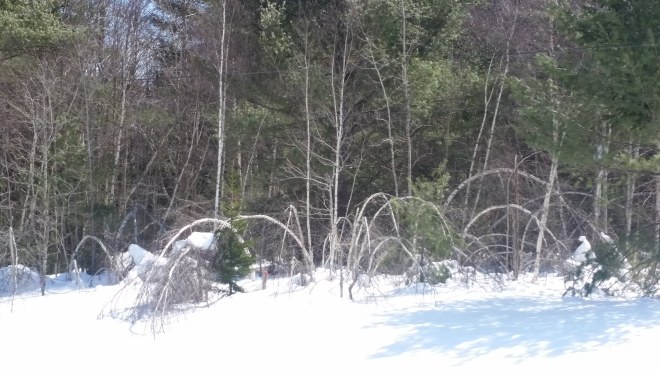A week or so ago, our friends Ann and Jules invited me and my wife over to dinner, and after an excellent meal, Ann played a recording for us. It was the poet Robert Frost, reading his poem, “birches“:
When I see birches bend to left and rightAcross the lines of straighter darker trees,I like to think some boy’s been swinging them.But swinging doesn’t bend them down to stayAs ice-storms do.
To set the record straight, my observation about fir and spruce saplings is valid. I’d seen heavy snow turn these little trees into white blobs, looking like small ghosts draped in sheets or drunken snowmen. Walking past I’d sometimes brush the snow away, and the little trees would spring back to their normal upright posture, as the following before-and-after picture demonstrates:
On my next hike in the Catskills after the dinner with Ann and Jules, I did notice some spindly saplings alongside the trail whose top branches had gotten stuck in the deep snow cover. It was an odd sight, but these trees were no thicker than sticks.

It wasn’t until the drive home that I saw birch trees (river birch, Betula nigra, I think) growing alongside the road — their top branches caught in the snow and seemingly cemented in place — and thus the trees bowed over in great white arches. It was a dramatic sight, and something I’d never seen before or if I had never noticed. And soon I realized, they were everywhere.

After taking a dozen photographs, I paused to consider this phenomenon. A shining white birch bent over in an arch is a reminder that flexibility has its advantages, in this case, the flex in the wood keeps the trunk from fracturing under the load of snow and ice, a fatal injury.
These slender, pliant trees made me think of a runner bending over to touch her toes. For runners, flexibility is a good thing: stretching is meant to keep tendons and muscles supple and prevent injury.
We need flexibility in our thinking, too, lest we become stubborn and unreasonable, as Haemon points out in Sophocles’ Antigone:
…it is no shame for even a wise man to continue learning. Nor should a man be obstinate.
One can see the trees on the heavy river-banks. Those that bend with the rushing current, survive, whereas those bent against it are torn, roots and all…
So, you, too, father, bend a little to the fury and try to change your mind.

Frost was 42 years old when he published “Birches,” and in the poem he recalls his boyhood with a sense of nostalgia. Apparently back in the day, “swinging birches” was a popular activity for New England youth; Frost describes a boy so engaged:
…He always kept his poiseTo the top branches, climbing carefullyWith the same pains you use to fill a cupUp to the brim, and even above the brim.Then he flung outward, feet first, with a swish,Kicking his way down through the air to the ground.So was I once myself a swinger of birches.And so I dream of going back to be.

But you can’t reverse the arrow of time, and in this regard, maybe it’s better to think of flexibility as a precondition, rather than a virtue. True, the young birch’s elastic stem allows it to survive snow, ice, and wind, but the species is shade-intolerant, which means in pursuit of sunlight it must grow tall, which it could not do without a stout trunk that is strong and, yes, inflexible. A birch cannot survive by creeping like a vine along the forest floor.
Flexibility is the precondition to making a decision or committing to a course of action. It’s like the concept of “optionality,” as used by strategists, which means having choices, or the term “symmetry,” as used by physicists, which describes a system before it crosses some tipping point into an irreversible new state.
There’s a trade-off between flexibility and growth — more flexibility might give you more time before the decision must be made — but it doesn’t make sense to remain flexible forever. Eventually options have to be exercised, which is to say an objective must be chosen and the assault launched.
As much as I’d like to have my ankle’s full range of motion restored, I’m not really interested in going back in time before the injury occurred. After all, who’s to say it wouldn’t get injured again just as before, or that I wouldn’t suffer some different injury and possibly worse? And even if I could dodge all running-related injuries, wouldn’t going back in time pose a risk of different and unfavorable outcomes with regard to things in my life that have turned out well? Taken to the extreme, going back in time could mean repeating the same futile actions endlessly, which was (is?) the fate of Sisyphus.

I’m optimistic about preserving some flexibility in life, even at an older age. After all, every day brings a new decision. Right now I’m balancing my time between hiking in the Catskills and taking some meetings that might lead to a new job. There’s a mix of feelings — both exhilaration and unease — and perhaps this how I would have felt as a young boy if I’d ever climbed to the top of a birch tree and thought about kicking out my feet.

In his most famous poem, “Stopping by Woods on a Snowy Evening,” Robert Frost wrote, I have “miles to go before I sleep,” and as someone who’s run some very long races, I sympathize. But instead of resting, I’d really like to run a few more miles.
Running the Long Path is available on Amazon (Click on the image to check it out)


[…] some places, birches and other saplings have bent gracefully under the load of ice now melted, but other trees have […]
LikeLike